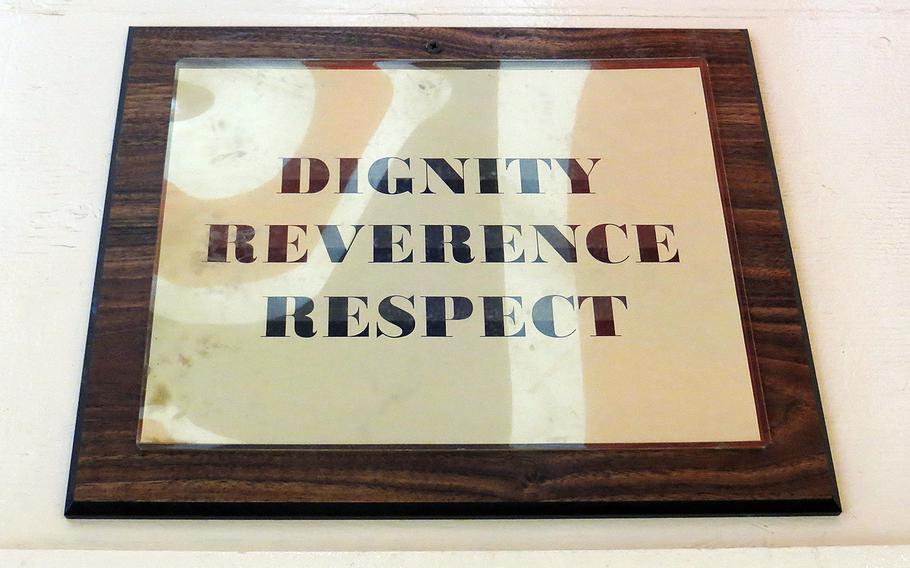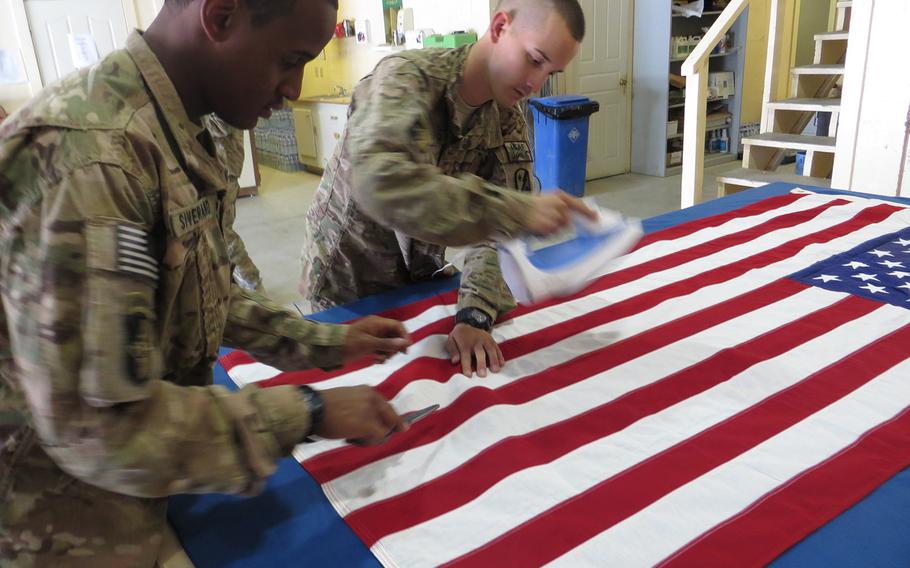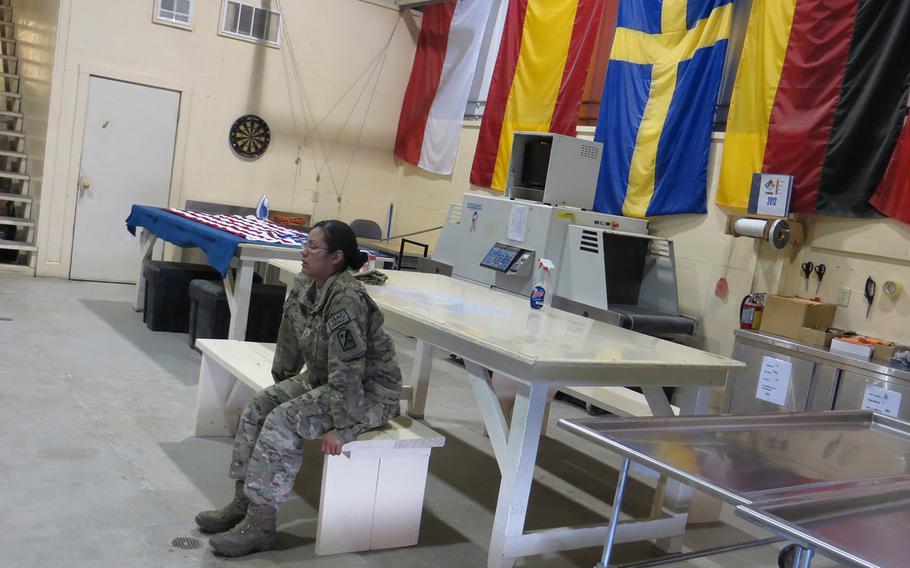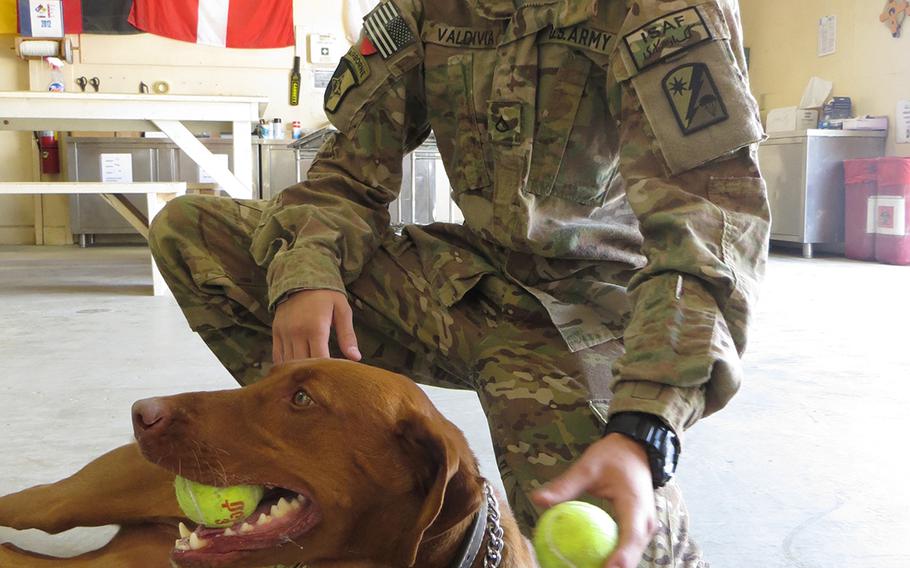what happens to the bodies of fallen soldiers

About this series
Stars and Stripes is looking at the mental health of U.S. soldiers in Afghanistan and how they cope with war'due south internal brunt while deployed. This serial is produced with the back up of a Rosalynn Carter Fellowship for Mental Wellness Journalism.
BAGRAM, Afghanistan — The kickoff trunk was the near difficult. Pfc. Durell Siverand found a family portrait in the dead soldier's wallet that showed him posing with his wife and two daughters. A mortar blast had killed him on the twenty-four hours he turned 21.
Siverand, ane yr older, had landed in Afghanistan less than three weeks earlier with the 54th Quartermaster Visitor of the 82nd Sustainment Brigade. The mortuary diplomacy unit occupies a large metal hangar at Bagram Air Field, some 40 miles northward of Kabul. In this infinite, where a small wall sign reads "Dignity Reverence Respect," death controls the order of life.
Siverand and Pfc. Alex Valdivia belong to 1 of the company'due south two teams of mortuary affairs specialists. As the "dirty hands" crew of their eight-member team, they set the bodies of fallen troops for the last flying dwelling.
Earlier deploying, Siverand worked in a morgue for a brusque time, and later arriving at Bagram last summer, he spent several days observing the unit that the 54th replaced. He was nervous merely set up on the morning of his initial 24-hour shift.
By evening, after delivering the private's remains to a cargo plane, he felt unmoored.
Standing outside the hangar, he smoked iii cigarettes in 20 minutes, his first iii since deploying. His mind fixed on the soldier's family photo. He wondered whether he could last hither.
"This is not something that everyone can do," said Siverand, of League City, Texas, recounting the episode some weeks later. "I won't prevarication — sometimes information technology'due south very hard for us, also. But you know that y'all've got to get these heroes dorsum to their loved ones as fast equally you can."
The Uniformed Services Academy reported in 2010 that one in 5 mortuary diplomacy specialists sent to Afghanistan or Republic of iraq returned with symptoms of mail service-traumatic stress disorder. The rate parallels that of infantry soldiers and suggests the mental burden borne by those who handle the expressionless.
Barely into their 20s, immersed in the carnage of war, Siverand and Valdivia are witness to fate's indifference.
"A lot of them are around my age," said Valdivia, 21, of Houston, "and yous know they all have someone who loves them — a mom, a dad, maybe a wife and kids. And now they're gone."
Skillful urgency
The procedure starts when the phone rings. An officer tracking flights into the base calls the mortuary affairs unit with an alarm that in thirty minutes to an hour an aircraft will touch down conveying a servicemember's remains.
The team in the hangar responds with good urgency. One member of the "make clean easily" crew contacts the unit of the deceased to assemble details for a example file that will travel with the body to the United states. 2 members iron an American flag to drapery over the top half of an aluminum transfer case that will hold the remains.
If their squad receives the call, Siverand and Valdivia climb into a box truck parked in the mortuary compound and drive to the flying line. In their reanimation, while playing "Telephone call of Duty" or poker, a relaxed repartee flows between them. In the vehicle, silence prevails.
The ii pull up close to the plane or helicopter. They enter the shipping and salute the dead servicemember and the military escorts accompanying the remains. The escorts help load the black body bag into the back of the truck. The body rides feet first. Siverand and Valdivia salute again, shut the door and return to the compound.
In the hangar, under the cold glow of fluorescent lights, they bicycle the remains on a gurney and finish beside a steel tabular array. They move to reverse sides of the handbag's bottom finish. Each pauses to steady his thoughts, to brace for a moment that never feels ordinary.
Valdivia unzips the bag. "I don't like doing it, so he does information technology," Siverand says. "But in one case it's open, you browse what's there and get to piece of work."
They begin at the feet or the lowest betoken still fastened to the trunk. Wearing latex gloves, they probe for personal effects in boots, pockets, sleeves and fabric folds earlier checking beneath clothing.
Items removed from the body accumulate on the steel table. Some other team member compiles a listing for the example file: photos and letters, cell phone and wallet, dipping tobacco and cigarettes, boxing bracelet and yellow ring. (The color of jewelry is described instead of assuming types of metal and gemstone.)
The two privates and then slip the objects into a plastic pocketbook that is tied to the body's left wrist. If the left arm is mutilated or severed, the adjacent option is the right wrist, followed past a leg or the body. Dog tags stay on the torso. Weapons, ammunition and classified documents revert to military custody.
One of the men zips the bag closed. They place the remains in an ice-packed storage cooler until receiving word of the shipping fourth dimension. They typically return to the flying line within ii hours.
Earlier parting the hangar, the pair lifts the body purse into the lower half of the transfer case. Biohazard numberless filled with ice rest under the head and feet and across the chest to slow decomposition. Other team members adhere the case's superlative half, already shrouded by the flag.
Subsequently a chaplain leads a prayer service, Siverand and Valdivia drive the body to the transport airplane. A memorial anniversary takes place on the runway apron. Dozens of troops, sometimes hundreds, stand up in columns that stretch straight dorsum beneath either side of the plane's tail, creating a human corridor. 8 servicemembers carry the transfer case through the corridor and ascend the loading ramp.
Siverand and Valdivia trail them into the plane to perform a short ceremony that ends with a salute. They sign over custody of the remains to the flying crew. They walk out the front door and bulldoze dorsum to the hangar. They endeavor to forget.
Devious details
Valdivia knows the dense, vehement odor of the dead. He has seen bodies maimed across semblance to the human class past roadside bombs. His hands have passed over bones pulverized by mortar rounds.
None of those sensations troubles him as much as opening a torso bag to find a soldier who appears unbroken, face up in repose.
"It'south harder when they're not really messed upward because they wait like an actual, alive person," he said. "If they're jacked up ... I just try to think of it as the person was never real. Because after dealing with so many it does become hard not to be affected."
The Army operates a second mortuary diplomacy "collection point" at Kandahar Air Field in southern Afghanistan. Every U.S. servicemember who dies in the state passes through Bagram or Kandahar en road to Dover Air Strength Base of operations in Delaware.
In the sequence of steps to repatriate remains, soldiers assigned to the collection points fulfill a duty at once vital and invisible, gaining perspective on the moral dimensions of a position that well-nigh of them, including Siverand and Valdivia, did non seek.
"We know what we do is important," said Staff Sgt. Charles Ellis, 48, of Brookhaven, Miss., who leads the company'due south ii teams of mortuary affairs specialists. "We also know that what nosotros practise isn't virtually us. There'due south something wrong if in that location'southward attention on united states of america."
Mortuary affairs units deploy to Transitional islamic state of afghanistan for six months. (In 2012, the Army cutting the length of tours for other active-duty units from 12 months to 9.) The short deployments reflect the armed forces's awareness of the mental trauma that can afflict mortuary affairs specialists, who are repeatedly exposed to death despite seldom leaving their base.
Valdivia has opened more than 40 body bags. Stray details resurface. He remembers the soldier with the same first and final name equally one of his friends in Houston. Another soldier carried a photo of his mother whose likeness reminded Valdivia of his ain.
"Y'all try not to acquaintance with the person," he said, "but occasionally you lot observe something about them and it hits yous: This person isn't all that different from me."
Siverand and Valdivia mostly refrain from lingering over a soldier's personal furnishings. A sense of self-preservation guides them as much every bit respect for the dead.
Siverand learned the need for disengagement while working on his first body, the private with a wallet photo of his wife and two daughters. Later, as he smoked outside the hangar, 1 of his superiors offered him solace and advice.
"I've been through this, and I know what information technology's like," the sergeant told him. "Don't personalize what you're seeing, don't spend a lot of time looking at their furnishings. Just keep your mind on sending them home."
Yet at that place exists a natural desire to empathize the life of a person who is met only in death. It is an impulse non easily subdued. "We're man — we're interested in people," Siverand said. "Sometimes you wish yous could know what someone was like."
The job requires them to skim written materials for classified information. Valdivia recalled the letter he pulled from the sleeve pocket of a 21-year-onetime specialist killed in a mortar strike in eastern Afghanistan. He saw the annotation was from the soldier's father and told Siverand, who urged him to set information technology aside.
Valdivia instead read on, curiosity overriding his improve judgment. He discovered that, after years of discord, the ii men had recently reconciled. The father wrote of his pride for the son and his anticipation of their reunion in a few months.
The body lying on the gurney was no longer just a proper name without a by. Valdivia felt a jolt of grief. The reunion would happen much sooner only for the worst reason. He wanted to unread the letter. He cannot escape the retentiveness.
Helping to say good day
Siverand and Valdivia find relief in the limited diversions available to soldiers in Transitional islamic state of afghanistan. They watch movies and play video games on their laptops, elevator weights at the gym, talk and text with family unit members in America. The respite provides separation from work that, if physically undemanding, can exhaust the spirit.
In addition to the remains of U.S. troops and noncombatant contractors, they receive the bodies of soldiers from nations supporting the U.South.-led war here. Along i wall of the mortuary hangar, the flags of Federal republic of germany, Poland and other coalition countries hang side by side, forming a veil of solidarity.
The two share another duty known every bit vehicle clearance, cleaning out armored trucks in which soldiers take been killed. They extract "leftover" remains — teeth, bone fragments, bits of flesh — and wipe away dried blood later bodies are removed.
"You lot have to become your mind set up before you go in," Siverand said. "I try to think of it as going into a scary movie. That helps brand what I'm about to meet seem less real."
For the ii friends, war has imposed clarity about the human being condition. Treatment the dead has instilled an awareness of life's brevity; observing the reactions of the living to the fallen has revealed how one person tin inspire many.
They prepared the remains of a 25-year-former sergeant killed in a mortar attack on Bagram Air Field final summer. Dozens of soldiers from his company appeared at the hangar for the prayer service. As they embraced and wept, Valdivia strained to stifle his emotions.
"I didn't know him and he nevertheless touched my heart," Valdivia said before his unit redeployed tardily last yr. "Yous could easily tell he had a big influence on people, and that makes you lot consider how y'all tin affect people and what you mean to them."
Like thoughts occurred to Siverand. "I stood there wondering, 'What did this guy do as a soldier to brand this many people care?' That'southward when you start saying, 'Hey, I want to be just like him.'"
Following the service, several soldiers hugged them in gratitude. In those moments, they realized the deeper purpose of their role, a purpose that sustains them against their ain internal struggle.
"When you lot see the faces of the guys who know the victims," Siverand said, "that'south when you sympathise the importance of the job. Y'all're helping them say goodbye."
news@stripes.com martinkuz@yahoo.com Twitter: @MartinKuz
Source: https://www.stripes.com/death-shapes-life-for-teams-that-prepare-bodies-of-fallen-troops-for-final-flight-home-1.267704



0 Response to "what happens to the bodies of fallen soldiers"
Post a Comment